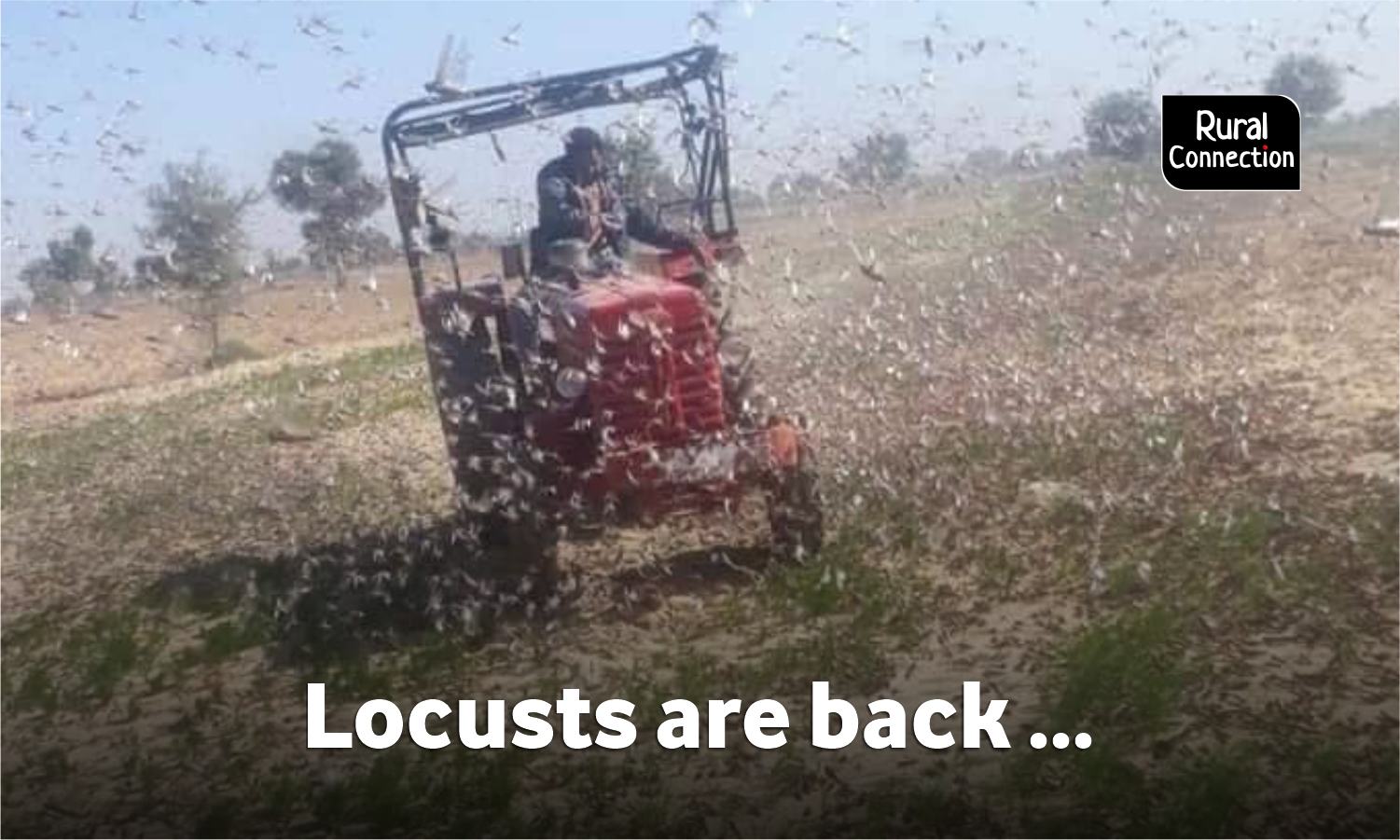Yesterday, on January 8, the tehsildar of Chitalwana block in Jalore district of Western Rajasthan issued a warning informing of another possible locust attack in the district.
The swarm of locusts, the warning said, was stationed near Sedwa in the neighbouring Barmer district and could attack any time. The swarm is estimated to be over 27 kilometres (km) in width with an unknown length. Local farmers have been advised to use methods, such as sprinkling kerosene oil and burning things to create smoke, beating drums/utensils, to ward off the attack.
All the villages of Jalore bordering Barmer district have been put on high alert. “We were expecting swarm of locusts to reach our tehsil today [January 9]. But, it hasn’t arrived yet and should come by tomorrow,” Nagaram Gurjar, tehsildar of Chitalwana told Gaon Connection. According to him, locust attack is not uncommon in the region. But, this year’s attack pattern is ‘strange’.
“Normally, locusts come around monsoon and leave by October. But, this year, we already have had three locust attacks on our rabi [winter] crops. Not much is left to eat or harvest now,” said Gurjar. “Apart from the timing, the route of locusts has changed, too. This time they have gone till Udaipur district, which wasn’t the case earlier,” he added.
Barmer, Jalore and Jaisalmer are the worst affected districts in Rajasthan. “For the last one month, we are suffering because of massive locust attack in our region. The last time I saw such widespread locust attack was in 1961 when I was in sixth standard,” Israram Vishnoi, former sarpanch of Parava village in Chitalwana block of Jalore told Gaon Connection.
He claimed the upcoming attack of locusts seemed worse than the previous one: “This time the width of locust swarm is said to be about 27 kilometres. Last month, the swarm was three to four kilometres wide and over 15 kilometres long, and still caused extensive damages.”
According to him, 170 villages in Chitalwana and Sanchore blocks of Jalore were worst-affected and had already lost between 50 per cent to 100 per cent of their rabi crops. Gurjar said of the total 162 villages in Chitalwana tehsil, 81 were affected due to locusts with a total crop loss of about 60 per cent.
A proper survey was underway. The main crop of the region is cumin (zeera) followed by mustard and wheat. Locust, a large-sized insect with 10 species of which four are found in India, feasts on all these crops. Due to its feeding behaviour — a desert locust swarm can eat as much food in a day as 10 elephants or 2,500 persons — causes extensive damage to the crops.
Locusts are coming from Pakistan and attacking parts of Rajasthan since mid last year. “They enter from Barmer and then proceed to Jalore and other districts. This time they even reached Udaipur… Depending on the wind direction and food availability, they make their way to Gujarat and eat whatever crops come their way,” said Shaitan Singh Vishnoi, a resident of D S Dhani village in Chitalwana block of Jalore. “Crop losses are insurmountable and cannot be compensated through crop insurance alone,” he added.
As per news reports, in the last locust attack in December month, almost 6,500 villages in nine districts of Rajasthan and two districts of Gujarat were affected. At present, it is claimed 312 villages are already under another attack of locusts, with maximum villages affected in Jaisalmer district followed by Barmer. There are fears of locusts making their way to Punjab, too.
“Locusts mainly lay eggs in Sindh region of Pakistan. Moisture in the soil helps in laying of eggs and growth of locusts… One of the ways to protect the crops is by spraying chlorpyrifos, whose price has been reduced to half by the state government,” said Gurjar.
Late last month, the state chief minister, Ashok Gehlot visited the affected villages and ordered an official survey (girdawari) of crop damages. As per the compensation package, per hectare of rabi crop loss can receive Rs 13,500, and up to a maximum of two hectares only. Thus, a farmer can avail Rs 27,000 crop compensation. But, Israram claimed farmers has suffered losses worth several lakhs.
Some news reports claim a loss of Rs 300 crore. Jaisalmer district alone had rabi sowing of 383,000 hectare of which more than 100,000 hectare is affected due to locust attack.
Commenting on the ‘unusual’ nature of locust attack, Israram claimed it could be due to the changing cropping pattern in the region. “Till a couple of decades back, we used to do any kharif crops, as we had no water to do rabi farming. Now, we have both electricity and irrigation facilities to do rabi crops, too. These locusts come looking for food and devour our crops,” he lamented.
Meanwhile, last month the Centre sent 11 teams to Gujarat to assess damages due to locust attack in the state. As per news reports, about 25,000 hectares area of castor, cumin and mustard crops in north Gujarat is affected.
The Union ministry of Agriculture and Farmers Welfare has a ‘Contingency Plan for Desert Locust Invasions, Outbreaks and Upsurges‘ last updated in June 2019. But, the contingency plan hasn’t come to the rescue of farmers like Israram, who are now staring at another round of locust attack as they collect rubber tyres to burn and cling utensils to scare away the pests.


















